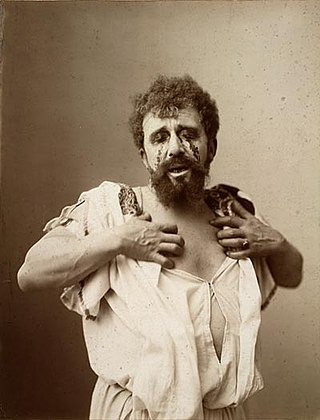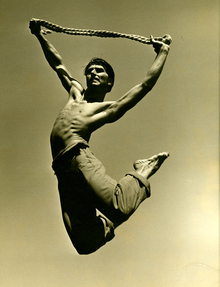Related Research Articles

Oedipus Rex, also known by its Greek title, Oedipus Tyrannus, or Oedipus the King, is an Athenian tragedy by Sophocles. While some scholars have argued that the play was first performed c. 429 BC, this is highly uncertain. Originally, to the ancient Greeks, the title was simply Oedipus (Οἰδίπους), as it is referred to by Aristotle in the Poetics. It is thought to have been renamed Oedipus Tyrannus to distinguish it from Oedipus at Colonus, a later play by Sophocles. In antiquity, the term "tyrant" referred to a ruler with no legitimate claim to rule, but it did not necessarily have a negative connotation.

Martha Graham was an American modern dancer and choreographer, whose style, the Graham technique, reshaped American dance and is still taught worldwide.

Appalachian Spring is an American ballet created by the choreographer Martha Graham and the composer Aaron Copland, later arranged as an orchestral work. Commissioned by Elizabeth Sprague Coolidge, Copland composed the ballet music for Graham; the original choreography was by Graham, with costumes by Edythe Gilfond and sets by Isamu Noguchi. The ballet was well received at the 1944 premiere, earning Copland the Pulitzer Prize for Music during its 1945 United States tour. The orchestral suite composed in 1945 was played that year by many symphony orchestras; the suite is among Copland's best-known works, and the ballet remains essential in the Martha Graham Dance Company repertoire.
Terese Capucilli is an American modern dancer, interpreter of the roles originally performed by Martha Graham. She is one of the last generation of dancers to be coached and directed by Graham herself. A principal dancer with the Martha Graham Dance Company for twenty-six years, she became associate artistic director in 1997 and from 2002 to 2005 served as artistic director, with Christine Dakin, seeing the organization and its dancers through the rebirth of the company. A driving force of Graham's work for nearly three decades, she is now Artistic Director Laureate.
Medea, Op. 23, (1946) is a ballet suite by American composer Samuel Barber. It was commissioned by the Ditson Fund of Columbia University for Martha Graham and was premiered on 10 May 1946, at Columbia University's McMillin Theater, New York City. The ballet was originally called Serpent Heart, but the work was revised in 1947 and retitled Cave of the Heart. Costumes were designed by Edythe Gilfond and the set was created by Isamu Noguchi. The original cast list included Graham, Erick Hawkins, Yuriko, May O'Donnell, and other members of the Martha Graham Dance Company.

Frederick "Erick" Hawkins was an American modern-dance choreographer and dancer.

Modern dance is a broad genre of western concert or theatrical dance which includes dance styles such as ballet, folk, ethnic, religious, and social dancing; and primarily arose out of Europe and the United States in the late 19th and early 20th centuries. It was considered to have been developed as a rejection of, or rebellion against, classical ballet, and also a way to express social concerns like socioeconomic and cultural factors.

Oedipus rex is an opera-oratorio by Igor Stravinsky, scored for orchestra, speaker, soloists, and male chorus. The libretto, based on Sophocles's tragedy, was written by Jean Cocteau in French and then translated by Abbé Jean Daniélou into Latin; the narration, however, is performed in the language of the audience.

La hija de Cólquide is a ballet score composed by Carlos Chávez in 1943–44 on commission from the Elizabeth Sprague Coolidge Foundation for Martha Graham. The title refers to the mythological character Medea, daughter of King Aeëtes of Colchis, in the story of Jason and the Golden Fleece. The ballet spawned several subsidiary works in Chávez's catalog including his Third String Quartet. When Graham eventually choreographed it, she wrote a new scenario and gave it the title Dark Meadow.
Cave of the Heart is a one-act ballet choreographed by Martha Graham to music by Samuel Barber. It was first performed on May 10, 1946, with the title Serpent Heart, at the second annual Festival of Contemporary American Music in the McMillin Theater of Columbia University. Serpent Heart was commissioned by the festival sponsor, The Alice M. Ditson Fund.
Errand into the Maze is a Martha Graham ballet based on a poem by Ben Belitt set to music by Gian Carlo Menotti. The surrealistic set was designed by Isamu Noguchi, the costumes by Graham herself. The dance uses the Greek myth of Ariadne and the Minotaur to explore the theme of conquering one's inner demons, more specifically the fear of sexual intimacy. The piece premiered at the Ziegfeld Theatre on February 28, 1947, with Graham as the protagonist, a sort of female Theseus, and Mark Ryder as the Minotaur-like character.
Diversion of Angels, initially titled Wilderness Stair, is a Martha Graham ballet performed to an original score by Norman Dello Joio. The premiere on August 13, 1948, at the Palmer Auditorium in New London, Connecticut, included a set designed by Isamu Noguchi. It was eliminated at the second performance. Diversion of Angels is in the Martha Graham Dance Company repertoire and that of American Ballet Theatre.

Bertram Ross was an American dancer best known for his work with the Martha Graham Dance Company, with which he performed for two decades. He was Martha Graham’s longtime dance partner and the originator of male roles in most of her major ballets from the 1950s and 1960s, including Adam in Embattled Garden, and both Agamemnon and Orestes in Clytemnestra. After leaving Graham's company, Ross taught, choreographed and formed his own dance company. In later life, he toured in a cabaret duo with his real life partner, the composer and pianist John Wallowitch.
Imagined Wing is a ballet choreographed by Martha Graham to Jeux de Printemps by composer Darius Milhaud. The piece was first presented on October 30, 1944, in the Elizabeth Sprague Coolidge Auditorium at the Library of Congress, Washington, D.C. Costumes were designed by Edythe Gilfond; the set was created by Isamu Noguchi. Elizabeth Sprague Coolidge commissioned the work, along with two other Graham dances, and musical scores for all three dances. Also on the program were Mirror Before Me set to music by Paul Hindemith and Appalachian Spring performed to music by Aaron Copland. Imagined Wing's initial showing was also its last. Following tepid reviews, the piece was never performed again.
El Penitente is a modern dance work by Martha Graham performed to music by Louis Horst. It premiered on August 11, 1940, at the Bennington College Theater, Bennington, Vermont, with costumes by Edythe Gilfond and a set by Arch Lauterer. Isamu Noguchi later redesigned the set and created a new mask.
Judith is a solo work created by dancer/choreographer Martha Graham. William Schuman composed the music. Charles Hyman designed the original set, which was replaced almost immediately by one conceived by Isamu Noguchi. He also added jewelry and a headdress. Jean Rosenthal provided the lighting. The piece premiered on January 4, 1950, at the Columbia Auditorium in Louisville, Kentucky.
Frontier is a solo dance choreographed by Martha Graham to music by Louis Horst. The set was designed by Isamu Noguchi; Graham created the costume. The work began as an ensemble piece, Perspectives: Frontier and Marching Song also known as Frontiers and Frontier. The ballet's Marching Song portion was set to music by Lehman Engle. The work premiered on April 28, 1935, at the Guild Theatre in New York City. By the end of 1935, Graham was performing Frontier exclusively as a solo. The piece was the first of her works to explore American identity through an archetypal character.
Chronicle is a modern dance work choreographed by Martha Graham to music by Wallingford Riegger. It premiered on December 20, 1936, at the Guild Theatre in New York City. The set was designed by Isamu Noguchi. Riegger's music was scored for piano, wind instruments and percussion; Noguchi's set was made up primarily of curtains, platforms and stairs. The original production was danced by Martha Graham and Group, the forerunner of the Martha Graham Dance Company. According to the program notes, the dance is based upon "the advent and consequences of war" and concerned itself with the "contemporary situation", referring to the impending conflict in Europe.

Blakeley White-McGuire born in Baton Rouge, Louisiana, is a dancer, choreographer, répétiteur, and educator. She is a Principal Guest Artist and former Principal Dancer of Martha Graham Dance Company. Described by Gia Kourlas of the New York Times as having a "powerful technique and dramatic instinct with an appealing modern spunk", White-McGuire has received widespread critical acclaim as a Graham dancer.
Clytemnestra is a 90-minute ballet choreographed by Martha Graham. It premiered on April 1, 1958, at the Adelphi Theatre in New York with music composed by Halim El-Dabh and sets designed by Isamu Noguchi. Following Cave of the Heart, Errand into the Maze, and Night Journey, Clytemnestra continued Graham's series of choreography inspired by Greek mythology.
References
- 1 2 "Night Journey (Ballet choreographed by Martha Graham". Performing Arts Encyclopedia, Library of Congress. Retrieved 6 February 2016.
- ↑ "Martha Graham Presents New Work 'Night Journey', with Score by William Schuman, at Harvard University Festival,". Dance Observer. June 1947. Retrieved 6 February 2016.
- 1 2 Martin, John (May 5, 1947). "Graham Dancers in Harvard Event". The New York Times. Retrieved 6 February 2016.
- ↑ Lederman, Minna (June 1947). "Graham at Harvard,". Dance News. Retrieved 6 February 2016.
- 1 2 3 4 5 "Night Journey (1960)".
- 1 2 3 4 5 Banes, Sally (February 20, 1998). Dancing Women: Female Bodies on Stage (Paperback ed.). New York: Routledge. pp. 157–167. ISBN 978-0415111621.
- ↑ Burt, Ramsay (Spring 1998). "Dance, Gender and Psychoanalysis: Martha Graham's Night Journey". Dance Research Journal. 30 (1): 34–53.
- ↑ Hodes, Stuart (August 22, 2011). Part Real, Part Dream: Dancing with Martha Graham (3rd ed.). 1408: Concord ePress. ISBN 978-0-981-7824-6-1.
{{cite book}}: CS1 maint: location (link) - ↑ Lille, Dawn. "Noguchi and Graham: A Pas de Deux". Art Times. Retrieved 7 February 2016.
- 1 2 3 4 Siegel, Marcia B. (May 17, 1985). The Shapes of Change: Images of American Dance (Paperback ed.). University of California Press. pp. 202–209. ISBN 978-0520042124.
- 1 2 3 Graham, Martha (1991). Blood Memory (Paperback ed.). Washington Square press. p. 97. ISBN 0-671-78217-7.
- ↑ Bannerman, Henrietta (1999). "An Overview of the Development of Martha Graham's Movement System (1926-1991)". Dance Research: The Journal of the Society for Dance Research. 17 (2): 14.
- 1 2 3 "Martha Graham Presents New Work 'Night Journey', with Score by William Schuman, at Harvard University Festival". Dance Observer. June 1947. Retrieved 8 February 2016.
- 1 2 Terry, Walter (May 5, 1947). "The Dance" (PDF). The New York Herald Tribune. Retrieved 6 February 2016.
- ↑ Franko, Mark (March 1, 2014). Martha Graham in Love and War: The Life in the Work (Reprint ed.). Oxford University Press. p. 97. ISBN 978-0199367856.
- ↑ Siegel, Marcia B. (1993). "Marthology". The Hudson Review. 46 (1): 183–188.
- 1 2 Macaulay, Alastair (September 13, 2007). "Portraits in Grief After Graham and Jungian Torment in Greek Legends". The New York Times. Retrieved 6 February 2016.
- ↑ Kisselgoff, Anna (October 24, 1987). "Dance: New Leads In 'Journey'". The New York Times. Retrieved 7 February 2016.
- ↑ "Early Spring". The New Yorker. February 17, 2003. Retrieved 7 February 2016.
- ↑ "Night Journey (1960)". Internet Movie Database. Retrieved 6 February 2016.
- ↑ Acocella, Joan. "Martha Graham on Film". The Criterion Collection. Retrieved 6 February 2016.